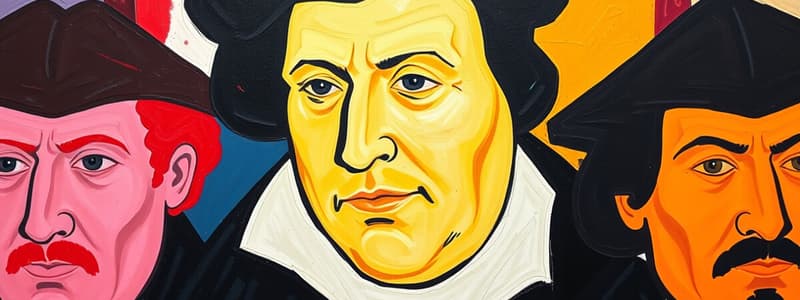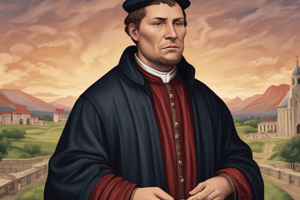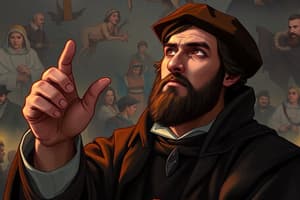Podcast
Questions and Answers
When was the Protestant Reformation?
When was the Protestant Reformation?
1517
What was the Protestant Reformation?
What was the Protestant Reformation?
A schism between loyalist members of the Catholic Church and those who believed differently.
What technological invention allowed the Protestant Reformation to spread rapidly?
What technological invention allowed the Protestant Reformation to spread rapidly?
The printing press
What were some objections people had against the Catholic Church? (Select all that apply)
What were some objections people had against the Catholic Church? (Select all that apply)
Who was the first main Protestant reformer, and where was he?
Who was the first main Protestant reformer, and where was he?
What did Martin Luther's brand of Reformation (Lutheranism) preach?
What did Martin Luther's brand of Reformation (Lutheranism) preach?
After Luther spread the Reformation to the German states, where did it spread next?
After Luther spread the Reformation to the German states, where did it spread next?
Who led the Reformation in Switzerland?
Who led the Reformation in Switzerland?
What was the Swiss Reformation like?
What was the Swiss Reformation like?
How did the Pope react to the Reformation?
How did the Pope react to the Reformation?
After the Swiss and German reformations, who was next?
After the Swiss and German reformations, who was next?
Where did Calvin preach and spread his reformation?
Where did Calvin preach and spread his reformation?
Calvinism was centered in the city of ________.
Calvinism was centered in the city of ________.
Calvinism sent ______ to cities across Europe.
Calvinism sent ______ to cities across Europe.
Calvinism created this sect of French Protestants called ________.
Calvinism created this sect of French Protestants called ________.
Calvinism supported this leader to convert Scotland to Protestantism.
Calvinism supported this leader to convert Scotland to Protestantism.
Match the following doctrines to their descriptions in Calvinism:
Match the following doctrines to their descriptions in Calvinism:
How did the Reformation affect Scandinavia?
How did the Reformation affect Scandinavia?
How did the Reformation play out in England?
How did the Reformation play out in England?
What happened after the Protestants took power in England?
What happened after the Protestants took power in England?
The Protestant Reformation concluded with which continent-wide war?
The Protestant Reformation concluded with which continent-wide war?
Study Notes
Overview of the Protestant Reformation
- Initiated in 1517 with Martin Luther's 95 Theses in Wittenburg, Germany.
- Concluded with the Thirty Years War (1618-1648) and the Peace of Westphalia, influencing Europe until 1945.
Definition and Impact
- A schism between the Catholic Church and reform-minded Christians known as Protestants, advocating for change against tradition.
- Protestants emerged as progressive figures challenging the established Church doctrine.
Technological Influence
- The printing press, invented by Johannes Gutenberg in 1439, facilitated rapid spread of Reformation ideas.
Criticisms of the Catholic Church
- Sale of indulgences, perceived as exploitation for heaven access.
- Church-led military campaigns in the Middle East causing suffering.
- Use of Latin in mass, alienating non-Latin speakers.
- Prohibition of priestly marriage.
Key Figures of the Reformation
- Martin Luther emerged as the first main Protestant reformer in the German states.
- Authored critical views against the sale of indulgences and advocated for salvation through faith alone.
- Declared the Pope a false leader and rejected the doctrine of transubstantiation.
Expansion of Reformation Ideas
- Following Germany, Reformation principles spread to Switzerland led by Huldrych Zwingli, who viewed the Mass as purely symbolic.
- John Calvin became a significant reformer in Switzerland and beyond, promoting Calvinism.
Calvinism Tenets
- Covenant of unconditional election where God predetermines salvation.
- Emphasis on innate human sinfulness and God's irresistible grace.
- Wealth is construed as an indicator of being chosen by God.
- Produced French Protestants known as Huguenots and influenced Scotland through John Knox in 1560.
Influence in Scandinavia and England
- Scandinavia adopted Lutheranism in the 1500s as its dominant faith.
- In England, Henry VIII's desire for divorce led to the formation of his own Church, ultimately creating Anglicanism after a brief return to Catholicism under Bloody Mary.
English Protestants and the New World
- Puritans sought to reform Anglicanism and fled to Holland for freedom, eventually migrating to America as Pilgrims in 1620.
Conclusion of the Reformation
- The Thirty Years War marked the end of this period, resulting in significant loss and political restructuring in Europe due to religious conflicts.
Studying That Suits You
Use AI to generate personalized quizzes and flashcards to suit your learning preferences.
Description
Test your knowledge about the Protestant Reformation with these flashcards. Learn key dates and definitions related to this pivotal movement in European history. Perfect for students and history enthusiasts alike!




